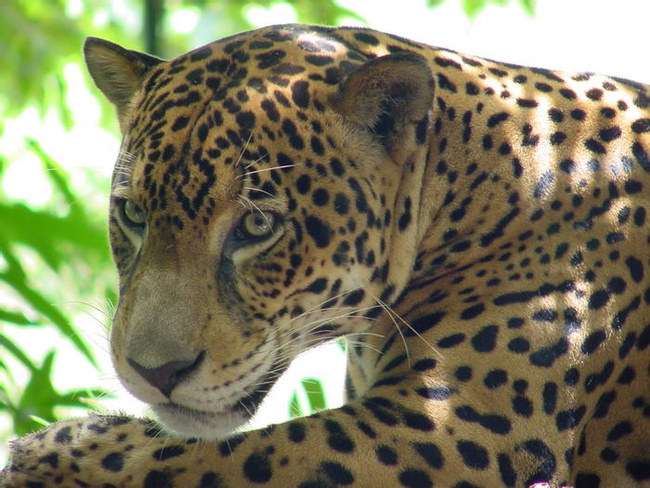
More about Jaguar
Range
In suitable habitats, it lives from northern Mexico to northern Argentina.
Physical Description
The jaguar has a yellowish brown coat with a white stomach and black spots all over its body. Its tail is short for a large cat – less than half the length of its head and body. This cat is adapted to grip prey with its great head, shoulders and forepaws.
Biology and Natural History
This endangered cat is the largest of Central American carnivores. The jaguar used to be common in many habitats, including mangroves, lowland savannas, wet and dry shrublands and forests up to 1000 m in elevation–but now they are rare except in large protected reserves. Because of the jaguar's conspicuous tracks, the market value of its pelt, its reputation for killing livestock, and its vulnerability to hound pursuit, their numbers and commonality are far reduced today. These cats suffer not only from hunting, but also from habitat destruction. They are sensitive to habitat size: in forest reserves a single male needs several hundred km2 for his home range, and females need somewhat less per individual. Sometimes young males will resort to areas with habitats far from normal for them. But because jaguars require such large territories, even in reserves their numbers do not compare to when they prowled most of Central America.
Jaguars will leave deep scratches on tree trunks, but it is not known whether they use urine or scratches on the ground to mark territories. A strong swimmer, the jaguar is able to cross rivers and other bodies of water. It tends to prefer damp areas like streambeds where footprints betray its presence, size, and whereabouts. The jaguar is mostly nocturnal but sometimes will sun during the day. At night it may roar at any time of year; some hunters call to them with imitations.
Unfortunately for this impressive predator, the jaguar does not seem to avoid the scent of men and may even follow them, although they rarely attack humans unprovoked and do not provide much of a threat to humans. The main threat to current Central America jaguar populations is no longer poaching, but deforestation for the sake of agriculture. Once roads enter a virgin area, jaguars and peccaries are the first large mammals to disappear.
Diet
The jaguar survives on a diverse diet: they prefer peccary, but also eat monkey, agouti, deer, bird, fish, lizard, turtle, or other animals. They've even been known to take sea turtles nesting in Surinam. Mud tracks have also indicated that jaguars will feed on dead fish, alligators, iguanas, or other dead animals beached by receding waters. Occasionally they will kill a domestic animal, but they usually kill and finish a single beast-unlike some other cats, jaguars are not wasteful predators, and even eat the entire ribs of their prey.
Height/Weight
Adult males are 50 to 100 kg, and adult females are two-thirds that size.
Taxonomy
Order: Carnivora
Family: Felidae
Source
Koford, C. B. in Janzen, Daniel H. Costa Rican Natural History. Chicago: University of Chicago Press, 1983.
Wilson, D. E. in Janzen, Daniel H. Costa Rican Natural History. Chicago: University of Chicago Press, 1983.
-Amy Strieter, Wildlife Writer
Jaguar Sightings
Similar Profiles
We believe travel is more than ticking destinations off a list – it’s about discovering new places deeply, feeling connected wherever you go, and knowing you have a trusted team behind you every step of the way.



